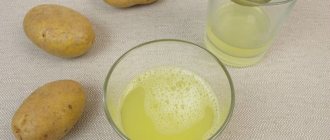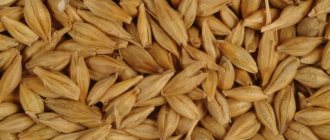Buckwheat is an amazing product that the whole country enjoys. It was this porridge that became the queen of the table among compatriots, but in Europe it is not very popular. The product can be consumed in various diets; buckwheat is recommended for gastritis. However, porridge, which was first grown by the people of Asia, also requires a special approach, which concerns the choice of cereals, as well as the characteristics of its use.
Useful properties of the product
The cereal received valuable qualities due to its composition. The components include vitamins B, E and A. The product also contains a lot of valuable microelements (zinc, magnesium, potassium, calcium, iron, etc.). Ready-made porridge is recommended not only for problems with the gastrointestinal tract, but also for iron deficiency anemia. Eating well-cooked buckwheat for gastritis with high acidity allows the patient not only to obtain valuable qualities, but also to avoid irritation of the gastric mucosa. Cereals are also valued due to:
- A large amount of vegetable protein that nourishes the body and gives it energy. Vegetarians never give up buckwheat.
- The composition, which contains vitamin PP, heals the gastric mucosa, restores its integrity, and eliminates irritation.
- Excellent and almost complete absorption.
- Absence of gluten.
To decide whether you can eat buckwheat if you have gastritis, you should fully assess the risks and go to see a doctor. The doctor will definitely conduct a full examination of the patient, and then prescribe him not only treatment, but also give recommendations regarding diet. It is this cereal that is loved by compatriots for its unique taste, aroma, as well as valuable nutritional properties and undoubted benefits.
Useful video
Check out the video about the benefits of buckwheat and its healing properties:
Buckwheat for gastritis with high or low acidity is an irreplaceable product, rich in all necessary substances. But any cereal, even healthy, can be harmful if used incorrectly and if you violate the general recommendations of the prescribed diet. When properly prepared and thoroughly boiled, the porridge turns out soft, very nutritious and tasty.
Buckwheat porridge is a real salvation for many people with stomach or duodenal ulcers. Many years ago, these unpleasant diseases began to be treated and maintained in the normal condition of patients using a buckwheat diet for the stomach with the addition of other safe foods. It is important to note that such a diet does not cause complications and side effects typical of modern medications that people prescribe for themselves without consulting a doctor.

In case of serious illnesses, it is not enough to start a buckwheat diet for the stomach, but you must first see a specialist. We assure you that not a single gastroenterologist will forbid you to eat buckwheat, and the misconception that buckwheat is a heavy food for the stomach is nothing more than a myth. The benefits of buckwheat for the stomach are obvious: the grain is perfectly digestible, hypoallergenic, does not cause bloating or other unpleasant symptoms, and will never cause abdominal pain after eating, unless, of course, you combine it with fatty meat or spicy gravy.
Features of use
Buckwheat is a very healthy product; porridge has a lot of beneficial properties, and therefore is often prescribed to people who suffer from gastrointestinal diseases. To prevent buckwheat from causing harm during gastritis, you should follow simple rules for its preparation:
- Cook with water, as milk and cream may reduce product absorption.
- You can eat it with a small boiled piece of fish or lean meat.
- Together with buckwheat for gastritis and pancreatitis, you can eat boiled, steamed or baked vegetables. You should not add seasonings or spices to such dishes.
- Serve well-cooked cereal, but only warm.
- For easy digestion and to avoid side effects, pre-grind the boiled porridge, for which it is convenient to use a kitchen machine or blender. You can also use a sieve.
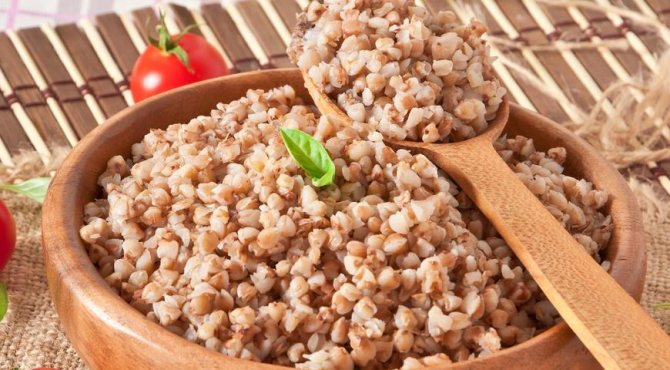
You should purchase grains that are not overcooked for cooking; you can even buy unheated grains. This product contains many valuable substances, microminerals, vitamins that will benefit the body.
Is it possible to eat raw buckwheat with kefir for gastritis?
Kefir with buckwheat in the morning is an excellent option for a healthy and tasty breakfast. This simple recipe has a variety of positive effects on the body - from maintaining a figure and getting rid of extra pounds to treating gastrointestinal diseases.
The popular fermented milk product contains about 22 types of various bacteria and fungi. Kefir improves digestion and normalizes intestinal microflora due to the content of yeast, lactic acid streptococci and bacilli, and acetic acid bacteria.
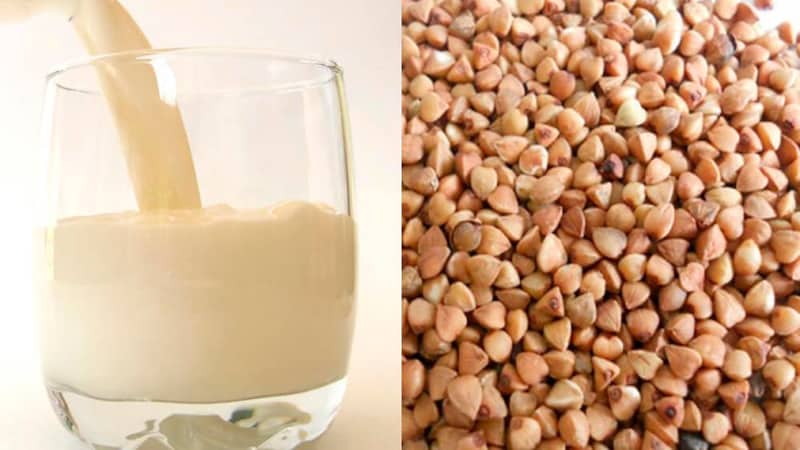
Buckwheat is considered a 100% eco-product. Pesticides and fertilizers are not used for its cultivation, since buckwheat takes root in any soil and fights weeds and pests on its own.
It does not contain gluten (gluten), and the content of microelements is higher than in other cereals:
- B vitamins, including folic acid;
- vitamins E, K, PP;
- potassium and magnesium;
- calcium and iron;
- zinc, copper and phosphorus;
- cellulose;
- amino acids.
The combination of these dietary products has a beneficial effect on well-being and health. And thanks to the double rich composition, the body is saturated with essential vitamins and microelements.
Buckwheat with kefir has the most pronounced effect on the body if taken on an empty stomach:
- the dish has a gentle effect on the gastrointestinal tract, starting the digestion process;
- cleanses the intestines;
- removes toxic substances from the blood;
- saturates the body, allowing you to get rid of hunger for a long time;
- improves overall well-being throughout the day.
The best time for consumption is before 8-10 o’clock in the morning, since the carbohydrates and proteins in the dish must have time to be completely absorbed before the next meal.

The benefits and harms of buckwheat with kefir in the morning on an empty stomach are determined by the frequent consumption of these products. Experts do not recommend eating buckwheat soaked in kefir every day for a long time.
Important ! The diet should be varied - if the same microelements and vitamins are constantly supplied to the body, this can negatively affect health.
It is best to consume the products in courses. For beginners, a two or three-day course of breakfasts with kefir and buckwheat is suitable. If a person does not experience discomfort or problems with the digestive system, the course can be extended. To cleanse the body and get rid of extra pounds, it is recommended to take a seven-day course, after which you need to take a break for the same period. It is enough to conduct 3-4 courses per year.
This breakfast should be consumed for:
- cleansing the gastrointestinal tract and preventing diseases of the digestive tract;
- increasing immunity;
- removal of waste and toxins;
- losing extra pounds.
In addition to the general improvement of the condition, buckwheat soaked in kefir:
- improves intestinal microflora;
- serves as a prevention of helminthic infestation;
- restores liver cells and improves its filtering functions;
- removes excess fluid from the body, relieves swelling;
- improves the functioning of the kidneys and pancreas;
- reduces high blood pressure;
- saturates the body with hemoglobin and increases iron levels in the blood, preventing the development of anemia;
- removes salts, toxins and poisons;
- enhances the breakdown of adipose tissue;
- normalizes water-salt balance;
- reduces the amount of sugar;
- replenishes the deficiency of B vitamins;
- normalizes the functioning of the central nervous system.
Fermented milk product and buckwheat are often used for medicinal purposes. A diet or breakfast made from these products is prescribed for various pathologies - pancreatitis, ulcers, diabetes.
An excellent option would be a dish of low-fat kefir and buckwheat for inflammation of the pancreas. It will alleviate the patient’s condition and prevent unpleasant consequences.
- Wash 1 cup of raw buckwheat and place it in a deep bowl.
- Pour in kefir so that it completely covers the cereal.
- Leave the mixture for 9 hours.
It is recommended to prepare the dish in the evening and take it the next day - 1 half for breakfast, the second for dinner.
The duration of the diet is no more than 12 days.
Experts recommend that patients with type 2 diabetes mellitus include this dish in their diet, since such patients need to reduce their carbohydrate intake.
Buckwheat with kefir for diabetes:
- raises glucose levels thanks to fiber, which increases the absorption time of nutrients;
- increases immune defense, weakened in patients with diabetes;
- normalizes carbohydrate metabolism due to the content of magnesium and calcium;
- supports the functioning of the heart and blood vessels and stabilizes blood pressure;
- protects the liver from obesity.
Diabetics should be careful when including buckwheat in their diet due to its ability to increase glucose levels. It is better to limit your intake of the dish and consume it under the supervision of a doctor.
With the help of buckwheat, filled with fermented milk product, waste and toxins are removed from the liver. To do this, pour half a glass of cereal with kefir and leave overnight. The dish will bring maximum benefits if you follow the recommendations:
- take in the morning on an empty stomach;
- do not eat or drink for the next 4 hours;
- take breaks after 10 days;
- Perform no more than 4 cleanings per year.
To enhance the effect, drink more fluid. For example, an infusion of St. John's wort or mint.
A dish made with kefir has an antihypertensive effect . Breakfast with buckwheat:
- cleanses blood vessels and dilates them;
- improves blood circulation;
- stimulates myocardial function.
Buckwheat with fermented milk product not only reduces blood pressure, but also maintains it within normal limits.
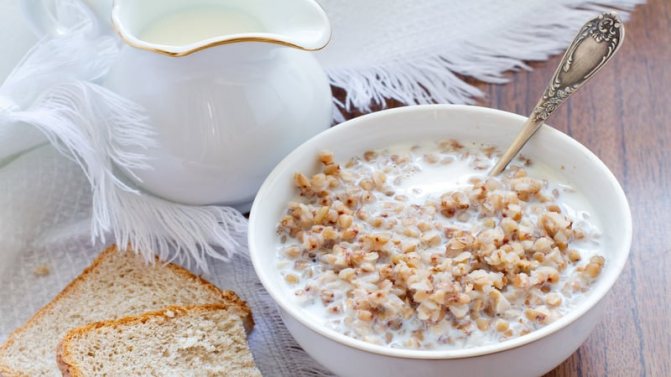
Dietary products in combination with each other are suitable for cleansing the intestines and blood vessels of toxins.
There are 2 recipes:
- Kefir with raw cereal is a classic recipe for breakfast.
- Boiled porridge (for those who cannot eat cereal raw). Pour 1 cup of buckwheat with water and bring to a boil over low heat. Drain the water and add the fermented milk product to the porridge.
Any of these dishes are consumed in the morning. After an hour, it is recommended to drink 1 glass of warm mineral water without gases. After another 60 minutes, you can eat other foods.
The cleaning system lasts 10 – 12 days.
Buckwheat is an excellent remedy for stomach and intestinal ulcers:
- Take 3 tbsp. l. buckwheat (crushed cereal).
- Pour 10 tbsp. l. boiling water
- Cover the drink tightly with a lid and let it brew in a warm place overnight (you can pour it into a thermos).
To prevent constipation, a classic recipe is suitable - soak the cereal in water overnight, drain it in the morning and mix the cereal with kefir. Drink on an empty stomach for no more than 10 days in a row.
Patients with damage to the gastric mucosa are recommended to include buckwheat in their diet for any form of the disease. By adding kefir to the cereal, which increases acidity, the diet:
- improves bile flow;
- normalizes digestion;
- removes toxins and prevents the process of decay in the intestines.
A stomach-healthy breakfast is prepared in a familiar way:
- Pour 0.5 cups of buckwheat into 1.5 cups of kefir.
- Leave the mixture to swell overnight.
Consume for breakfast on an empty stomach.

The buckwheat-kefir diet is an effective way to lose extra pounds. Both products are affordable, easily absorbed by the body, saturate for a long time and do not cause discomfort in the gastrointestinal tract.
Important! When taking buckwheat with kefir for weight loss, fill the cereal only with low-fat or low-fat kefir.
The average duration of the diet is 5-6 days. Then take a break for 4-5 days. Resume taking buckwheat with kefir for 1 week. This way you can get rid of 5-6 kg, cleanse the intestines and remove toxins from the blood.
The main thing in this simple and popular option is to prepare the buckwheat correctly. Cooking it using classical methods is not recommended.
What happens if you stew buckwheat in kefir? It will simply lose its beneficial properties. Therefore, we proceed as follows:
- Fill the raw cereal exclusively with water and leave it to swell overnight.
- Drain off the remaining water and pour kefir over the cereal.
However, some nutritionists allow you to simplify the cooking process - immediately pour the buckwheat with a fermented milk product.
Important! You cannot add butter, salt or sugar to a dish with this recipe.
Cinnamon enhances the fat-burning properties of buckwheat and kefir. In addition, spicy spice:
- reduces appetite;
- speeds up metabolism;
- reduces cholesterol and glucose levels;
- promotes the breakdown of fat cells.
To get a healthy and flavorful dish, buckwheat is prepared in the classic way. In the morning, add 1 tsp to the prepared mixture. cinnamon powder.
Ground buckwheat is just as welcome a guest in a healthy diet as whole grains. At the same time, its benefits for the body are no less. When crushed, buckwheat can be used to prepare a tasty and dietary drink.
Ingredients:
- 200-250 ml kefir;
- 2 tbsp. l. ground buckwheat;
- 1 banana;
- 1 peeled apple, without peel or seeds.
All components of the drink are placed in a blender and blended until smooth. The mixture is consumed for breakfast as a smoothie or eaten with a spoon like yogurt. The tasty drink has the same beneficial properties as buckwheat and kefir.

Combining the two dietary products brings only benefits to most people. Harm from buckwheat with kefir in the morning on an empty stomach is possible if they are consumed excessively.
Symptoms of “overdose”:
- feeling of discomfort in the stomach;
- increased gas formation;
- diarrhea.
Keep in mind that such breakfasts and diets are not suitable for everyone. Main contraindications:
- hepatitis;
- vascular diseases;
- hypotension, as these products contribute to an even greater decrease in blood pressure;
- severe kidney disease, especially renal failure - in this case, excessive load on the kidneys in the form of fluid excretion can aggravate the patient’s condition;
- chronic diseases of the gastrointestinal tract;
- underweight.
Buckwheat with kefir is an excellent dietary breakfast. The rich composition of these two products cleanses the gastrointestinal tract, improves digestion, vascular function, liver and kidneys. In addition, with their help you can lose a couple of extra pounds.
Nutritionists recommend consuming the dish in the morning on an empty stomach. However, a healthy breakfast also has contraindications. It is especially important to consume grains found in kefir in moderation.
source
An unbalanced diet and consumption of foods rich in fats, fast carbohydrates and preservatives lead to the accumulation of toxins in the body, slowdown of metabolism and disruption of the digestive process. The results of such poor nutrition can be excessive weight gain, chronic constipation, atherosclerosis, anemia, and problems in the cardiovascular system. The first step towards acquiring the right eating habits, which will be the key to restoring normal weight and healing the body, can be a kefir-buckwheat diet, which improves metabolic processes and intestinal function.
Buckwheat, like kefir, is a dietary product that, despite its high nutritional value, helps normalize weight and, thanks to its balanced composition, heals the body. Nutritionists insist on the combination of these two components in dishes, since, complementing each other, they enhance the beneficial effect, help cleanse the body of waste and toxins, and this is the first step to restoring health. Dishes prepared from buckwheat and kefir will be useful for various diseases.
- For diabetes mellitus type 1 and 2. Buckwheat helps remove bad cholesterol from blood vessels, which prevents atherosclerosis - one of the factors in the development of type 2 diabetes. In addition, dishes prepared from this grain do not increase blood glucose levels and satisfy hunger for a long time, so buckwheat can be consumed without fear of harming your health. Kefir lowers the glycemic level in the blood, which is very important for diabetes.
- For diseases of the pancreas. Nutritionists recommend eating buckwheat porridge, cooked in water without oil and spices, already on the 5th day after an attack of pancreatitis. If the disease is in remission, you can and should consume buckwheat in combination with low-fat kefir, since these two products can stimulate the pancreas, renew the cells of this organ, reduce the inflammatory reaction, thereby eliminating pain.
- For gastritis. Low-fat kefir is an essential component of the diet for gastritis with low acidity, since, like all fermented milk products, it improves food digestion, relieves irritation, and normalizes the level of acid-base balance. At the same time, buckwheat and kefir restore the gastric mucosa and suppress the growth of pathogenic bacteria.
- For obesity, nutritionists recommend using kefir and buckwheat to cleanse the body of toxins, as well as speed up metabolic processes, thanks to the combination of plant and animal proteins.
- For intestinal disorders, consuming kefir with buckwheat helps normalize peristalsis and eliminate constipation. Buckwheat, like an absorbent, absorbs and then removes accumulated toxins from the intestines. Kefir, thanks to the content of live cultures of lactobacilli, restores the intestinal microflora, eliminates rotting processes, suppressing pathogenic bacteria. This combination of breakfast foods can improve bowel movements and eliminate symptoms of flatulence and intestinal discomfort.
- In case of cancer, kefir with buckwheat can be used as an aid, since these products, due to the content of vitamin C and quercetin, have antioxidant properties. In addition, working in tandem, they help improve immunity, which is important for tumor diseases, since the use of radiation and chemotherapy weakens the body's defenses.
- For diseases of the cardiovascular system, dishes prepared with buckwheat and kefir help cleanse blood vessels and reduce their permeability thanks to routine. The high content of potassium, magnesium and sodium improves the functioning of the heart muscle and normalizes blood pressure.
Any product can benefit the body only if it is consumed correctly, so when following the kefir-buckwheat diet, the main thing is not to overdo it. There are several ways to follow this principle of nutrition for the purpose of health improvement, as well as weight loss.
To improve digestion and cleanse the body, it is not necessary to make up your entire daily diet only from buckwheat in combination with kefir; it is enough to consume these products as a hearty and healthy breakfast, which will relieve hunger for a long time and will help normalize digestion throughout the day. If you follow a drinking regime and proper nutrition, limiting the consumption of animal fats and fast carbohydrates, such a diet will contribute to a gradual loss of body weight and consolidation of the achieved results in weight loss. The recommended duration of the body cleansing course is 10 days, after which you should take a break for 3 months. In total, up to three cleanings can be carried out per year.
In order to diversify your breakfasts, you can prepare buckwheat with kefir in various ways, which are presented below, while it is necessary to take into account the characteristics of the body and the presence of chronic diseases, as well as contraindications for certain options for consuming these products.
The effectiveness of the diet does not lie in the number of kilograms lost, but in the duration of maintaining the achieved results. Fasting days are one of the ways to keep your weight within limits, as well as lose extra pounds gained during the holidays or food breakdowns. However, few people manage to control their appetite during the day by drinking only green tea or fruit. In this case, buckwheat with kefir will help, since this combination of products is quite nutritious, while the dishes are low in calories.
Rules for observing fasting days on buckwheat and kefir:
- you should consume no more than 200 g of cereal (meaning the weight of raw buckwheat) and one liter of low-fat kefir per day;
- the dish prepared in advance should be divided into 5–6 servings;
- There should be equal intervals between meals, no more than 3 hours, during which it is allowed to drink green tea without sugar;
- An hour before bedtime, you can drink a glass of kefir at room temperature.
Fasting days on buckwheat and kefir should be carried out systematically: first once a week for 2 months, and then once a month for a year.

Green tea, especially if it is made from fresh leaves of fruit trees, contains a large amount of vitamins
Green tea should be drunk either hot or warm, since cold green tea is poison for the body.
Many sources describe a strict diet on buckwheat and kefir, which involves eating only these products in limited quantities for 4–5 days. Opinions about this method of losing weight are controversial, since nutritionists do not recommend using mono-diets for various reasons.
- A poor diet leads to a deficiency of certain beneficial nutrients, which certainly affects health. With prolonged adherence to a mono-diet, vitamin deficiency is possible, and in special cases, hypervitaminosis (poisoning of the body with toxins due to excessive accumulation of vitamin-like substances).
- A monotonous diet does not contribute to weight loss, as it creates a subconscious desire for satiety. The body, not receiving the necessary substances, gives a hunger signal, and a person may feel hungry even after a meal.
- Such a diet causes stress, which only contributes to a slowdown in metabolism and the accumulation of extra pounds.
- The main result of a strict diet is achieved by removing toxins, unloading the intestines, and also removing excess fluid from the body, because buckwheat helps relieve swelling. Such a diet, used for a short period, is not capable of affecting the amount of subcutaneous and internal fat. As a rule, after returning to the usual way of eating, the scales gradually return to their previous values.
- Long-term consumption of the same foods develops a persistent aversion to them.
Those who decide to try this diet on themselves should listen to the state of their body especially carefully. At the first symptoms of exhaustion, heaviness in the intestines, pain in the stomach, you should stop the diet.
The result of a strict buckwheat-kefir diet is difficult to predict. You will certainly get rid of a large number of problems with the gastrointestinal tract, but the number of kilograms lost depends entirely on your initial weight, the presence of toxins and excess fluid in the body. If you have a normal weight, but you don’t like it, the buckwheat-kefir diet will not help.
To ensure that such a diet does not cause harm, you should know the nuances of preparing buckwheat with kefir, which may differ for various diseases:
- for pancreatitis and gastritis, you should choose only low-fat kefir or a product with 1% calorie content;
- for any diseases of the gastrointestinal tract, you should not prepare a dish by soaking buckwheat in kefir, since the kernels after swelling still remain hard and can cause an exacerbation of the disease;
- to remove toxins, for example, to prevent cancer, it is recommended to choose green varieties of buckwheat, as it contains more antioxidants;
- If you are prone to constipation, you should not choose homemade kefir older than two days, since such a product tends to strengthen, while fresh, one-day old kefir, on the contrary, promotes loose stools. As for store products, they are neutral in this regard;
- for diabetes, preference should be given to 1% kefir of a proven brand. Manufacturers often add starch to low-calorie fermented milk products as a thickener; this should also be taken into account when converting the dish into bread units.
People with various chronic diseases should use buckwheat with kefir for health purposes only after prior consultation with their doctor.
There are several options for preparing buckwheat with kefir, which use different methods of heat treatment of cereals, as well as forms of buckwheat.
- Buckwheat kernels are buckwheat, hulled. Thanks to heat treatment by frying or steaming, the kernels acquire a brown color of various shades.
- Green buckwheat - the same buckwheat kernels, peeled and sifted. This product cannot be heat treated, therefore it contains more useful substances. Green buckwheat cooks less well and has a shorter shelf life.
- Prodel - crushed buckwheat kernels. Porridge from such cereals is less crumbly, but much softer and more tender than from whole grains.
- Smolensk groats are highly ground grains. This product is used for preparing dishes in baby food and for the elderly.
- Buckwheat flour is made from both processed kernels and green buckwheat. This flour is used to make pasta for people with gluten intolerance or an allergic reaction to this substance.
Let's look at the simplest ways to prepare and consume buckwheat with kefir:
- buckwheat kernels - 3 tbsp. l;
- kefir - 250 ml.
- Rinse buckwheat under running water and drain in a colander or fine sieve.
- Transfer the grains to a glass or ceramic container and fill with kefir.
- Cover the buckwheat and kefir with a lid and refrigerate overnight.
- By morning, the buckwheat kernels will absorb the kefir, swell and become soft.
This dish is prepared in advance 8–10 hours before the intended meal. It is recommended to soak the buckwheat in the evening so that the dish is ready for use in the morning. The number of servings is calculated depending on the method of dieting (breakfast only, fasting day or strict diet).
- buckwheat kernels - 100 g;
- water - 200 ml;
- kefir - 200 ml.
- Pour the washed cereal with water and simmer over low heat until it boils.
- Turn off the heat, cover the saucepan with a lid and leave the porridge to steep for 30 minutes.
- Mix boiled buckwheat with kefir and consume according to your diet.
- green buckwheat kernels - 3 tbsp. l;
- boiling water - 1 tbsp;
- kefir 1% fat - 1 tbsp.
- Pour green buckwheat into a deep and wide container and rinse with cold water.
- Drain the cold water and add boiling water.
- Cover with a lid and wrap in a terry towel.
- After 30–40 minutes, green buckwheat will absorb all the liquid and become suitable for consumption.
- Mix crumbly, soft cereal with kefir.
This method of preparation allows you to preserve more useful vitamins and microelements found in the cereal.
- kefir 1% fat - 1 tbsp;
- buckwheat flour - 1 tbsp. l.
- Add buckwheat flour to kefir at room temperature and stir.
- Infuse the drink for 10–15 minutes until the flour swells.
- Take on an empty stomach instead of first breakfast or 2 hours before bedtime.
Boiled buckwheat itself has virtually no contraindications and is used in dietary nutrition for various gastrointestinal diseases. However, the combination of raw buckwheat soaked in kefir can be harmful to the body, since such a dish is quite difficult to digest and can injure the mucous membranes and cause inflammation. Therefore, before you decide to use the kefir-buckwheat diet, you should consult with a doctor or nutritionist who will recommend which of the options discussed above for preparing buckwheat with kefir, as well as methods of following the diet, is suitable in your specific case.
Contraindications to the use of the kefir-buckwheat diet are:
- pregnancy;
- lactation period;
- children under 14 years of age (if there is no tendency to obesity);
- elderly age;
- gastritis with high acidity;
- pancreatitis in the acute stage;
- stomach ulcer;
- chronic colitis;
- chronic liver diseases;
- haemorrhoids.
In order for such nutrition to bring more benefit than harm, you should start the diet and exit it gradually, since any sudden change in the usual diet is stress for the body. When trying the kefir-buckwheat diet for the first time, you should test the body’s reaction to the dish, for example, by including it in your daily diet once a week. If there are no signs of indigestion, you can cleanse the body by using the dish as breakfast or try a more gentle diet, the menu of which, in addition to these two products, also includes other low-calorie dishes.
source
Buckwheat is considered a unique product - it contains a lot of useful substances and is approved for use in various diets. Is it possible to eat buckwheat if you have gastritis, in what form is it beneficial to eat it, and in what forms of the disease is it allowed to be consumed? Buckwheat is allowed for gastritis, but it is important to know the nuances of its use, especially if the patient has an exacerbation of gastritis or a special form of the disease.
One of the features of buckwheat is its high ecological purity, which in itself is beneficial for the body. The ecological purity of buckwheat is associated, first of all, with the fact that the plant is practically not susceptible to pests, which means that it is rarely subjected to chemical treatments. In addition, buckwheat has a unique composition, which allows it to be in third place on the list of the most healthy foods.
It contains organic acids, vitamins, some carbohydrates, macro- and microelements, complete. Buckwheat does not contain gluten, so it can be consumed even if you have celiac disease. And in its kernels you can find B vitamins (pyridoxine, thiamine, niacin, riboflavin), Omega-3, vitamin C, folic and pantothenic acids. In addition, buckwheat contains selenium, manganese, copper, magnesium, calcium, zinc, phosphorus, sodium, and potassium. All this suggests that buckwheat is very beneficial for the stomach.
Buckwheat porridge is useful for gastritis; you just need to follow a few nuances in its preparation and consumption for various types of gastritis.
Diet for gastritis is one of the mandatory components of the treatment of the disease, since a damaged stomach cannot fully cope with the function assigned to it.
The task of dietary nutrition is not only to be gentle on the digestive organs, but also to supply the body with all useful elements. Buckwheat and dishes made from it fully fulfill all these requirements.
With gastritis, most often there is an imbalance in the acid balance, so dishes with different types of gastritis from buckwheat need to be prepared differently. It is allowed to use it without restrictions only during the period of remission. During an exacerbation of the disease, you can eat buckwheat porridge, but it is advisable to boil it, first crushing it, to a semi-liquid consistency. And after the attack of exacerbation is relieved, you can return to the previous, not so gentle, cooking option.
Video on the topic:
There are general rules for preparing buckwheat that must be followed to make eating buckwheat most beneficial:
- Buckwheat should be cooked in water, since milk and cream can reduce the degree of digestibility of the product;
- It is better to eat cooked buckwheat with a small piece of boiled lean fish or meat;
- for gastritis and pancreatitis, it is recommended to eat boiled or baked vegetables along with buckwheat (it is not recommended to add spices or seasonings to such dishes);
- Buckwheat dishes should be eaten exclusively warm;
- for good absorption and to avoid side effects such as irritation of the mucous membrane, it is recommended to pre-grind the porridge (for this you can use a blender or rub it through a sieve);
- for cooking, it is better to purchase grains that are not overcooked; it is better to purchase thermally untreated grains, since such a product contains more useful substances and microelements.
For gastritis with high acidity, buckwheat is consumed in a well-cooked form, helping not only to supply the human body with useful substances, but also not to irritate the gastric mucosa. For gastritis with reduced secretion or atrophic gastritis, there is a different way to consume buckwheat. There are also specific uses during periods of exacerbation of the disease or stomach ulcers.
The following properties also give buckwheat special value:
- contains a large amount of vegetable protein that nourishes the body and supplies it with energy;
- the presence of vitamin PP, which promotes the healing of the gastric mucosa and restoration of its integrity;
- almost complete digestion of cereals;
- low amount of carbohydrates, which is good for diabetics;
- Thanks to the high percentage of vitamin P, buckwheat dishes have an anti-inflammatory effect, helping the body fight various infections.
When gastritis with high acidity is diagnosed, it is recommended to prepare the following dishes from buckwheat:
- the first is soup in vegetable broth made from potatoes and carrots with the addition of separately cooked buckwheat. You can season the soup with butter or vegetable oil, low-fat cream and dill;
- the second is buckwheat porridge, boiled in water, which is excellent as a side dish for steamed cutlets or meatballs made from lean meat, for stewed or oven-baked chicken and rabbit meat, and goes well with vegetable caviar, fresh tomato salad and boiled vegetables ;
- buckwheat milk porridge is also welcome in the diet for gastritis;
- In addition, buckwheat cooked until half cooked is mixed with minced chicken or beef, carrots, onions, egg yolk, and salt are added in a small amount. The resulting mass is formed into cutlets and baked in the oven with butter;
- By grinding pre-roasted unprocessed cereal into powder in a coffee grinder, it can be used to make flatbreads, added to cutlets, or eaten raw with food. You can consume several teaspoons of buckwheat flour daily, washing it down with water or compote.
All these dishes are perfectly digestible by the stomach.
Buckwheat for gastritis with increased secretion can be prepared in different ways and combined with various products, but the following rules must be followed:
- when preparing soups, use only low-fat broths;
- To season the soup, you cannot fry it; it is recommended to use vegetable oil or low-fat cream instead;
- cook porridge in water, not milk, leaving a little water after cooking;
- The cereal should be well boiled; it is better to overcook it a little than to leave it hard - this can harm the body.
For gastritis with high acidity, buckwheat can be not only a complete dish, but also a medicine for relieving heartburn. To do this, it must be fried without oil in a dry frying pan, turned into powder using a coffee grinder and consumed when heartburn bothers you in the amount of one pinch, washed down with warm milk or plain water.
It is recommended to consume raw buckwheat on an empty stomach for 2 weeks. For this in the evening, 1 tbsp. A spoonful of buckwheat is poured with water in a 1:1 ratio, and eaten in the morning half an hour before breakfast.
Video on the topic:
With hypoacid gastritis, there is a lack of food enzymes for food processing. The diet for this form of gastritis includes foods that help stimulate gastric juice, without irritating the mucous membrane or overloading the stomach.
With this form of gastritis, buckwheat must be included in the diet, but porridge from it must be prepared sufficiently viscous, not crumbly, so that it is easy for the stomach to cope with it.
For gastritis with reduced secretion, you can prepare the following dishes:
- soups with buckwheat in meat or mushroom broth. They help improve digestion. You can add potatoes, carrots, onions, and herbs to them;
- porridge. They are seasoned with a small amount of cream or vegetable oil (pumpkin, sesame, olive);
- buckwheat porridge as a side dish. With low acidity, mushrooms, lean meat (lightly fried and then stewed), raw vegetables, sour gravies and sauces are allowed in the diet. Porridge with such additives will not only suppress hunger, but also replenish the body with useful substances.
When consuming cereals, you must adhere to your rules:
- prepare soups based on mushroom or meat, but not fatty broths;
- use vegetable oil rather than butter as a dressing for porridges;
- You can use mushrooms or vegetables as a side dish;
- It is good to serve buckwheat dishes with uzvar, jelly, compotes, and juices.
You can cook cereal not only by boiling it, but also by using another, non-thermal method of preparing buckwheat, especially when you want to get the maximum amount of valuable and nutritious elements from the dish. For this, 3 tbsp. spoons of buckwheat are brewed with 300 ml of boiling water, cover with a lid and leave overnight (instead of water, you can use hot milk in the same proportion). The finished buckwheat is ground to a semi-liquid state in a blender. Each time they prepare a new portion of this porridge. If it is difficult to eat buckwheat uncooked, you can reduce the portion. This dish should be consumed every day for two weeks.
Raw buckwheat with kefir is also good for gastritis with low acidity. Low-fat kefir itself is an essential component of a diet for gastritis with reduced gastric secretion, since it, like other fermented milk products, improves food digestion, increases stomach acidity, relieves irritation, and normalizes the level of acid-base balance. At the same time, buckwheat with kefir restores the gastric mucosa and suppresses the growth of pathogenic bacteria. To prepare such a dish, pour kefir over the ground cereal and wait for it to swell. This mixture can even be eaten cold.
During the acute period of the disease, a person often feels severe pain and suffers from vomiting. In the first days, the patient is advised to refuse food, replacing it with rosehip infusion, weak sweetened tea or table water. On the 2-3rd day, you can introduce viscous soups and liquid porridges into the diet, but buckwheat porridge should be viscous, it has an enveloping effect on the inflamed mucous membrane.
Eating any food must be portioned; overeating, including buckwheat porridge, is not allowed. The product is eaten only in grated or highly crushed form.
I really like porridge, especially buckwheat, but I was diagnosed with erosive gastritis. Is buckwheat contraindicated for me or not?
For erosive gastritis, the diet prescribed is quite strict, but among the permitted foods there are porridges, including buckwheat. It is better to cook it in water or milk diluted 1:1 with water.
source
Features of preparing and consuming buckwheat for gastritis
Before you start cooking, you need to find out from your doctor exactly whether you can eat buckwheat if you have gastritis. This product is neutral because it does not pose a risk to patients. However, it is still worth exercising maximum caution, especially when it comes to consuming porridge during an exacerbation or special forms of the disease.
Increased acidity
There are several basic rules for taking buckwheat porridge for gastritis with high acidity, all of them require strict adherence. These include:
- Using cereals when preparing soup, which is prepared with lean meat and vegetables. For dressing, you cannot fry it; instead, it is better to use low-fat cream and vegetable oil.
- Cook porridge not in milk, but in water, leaving a little water after cooking.
- It is good to boil the cereal, which is better to make it disintegrate than to leave it hard. In the second case, the dish will only harm the body.
- Use lean meats as a supplement. It is ideal to use soft chicken, which should first be boiled, baked in the oven or steamed.
- Use cooked buckwheat to steam cutlets. To do this, you need to mix minced turkey or chicken with ground porridge, add a little salt and send it to cook in a steam bath.
Any aggravated condition of the gastrointestinal tract requires exclusion from the diet of dishes with seasonings, large amounts of salt, pepper, vinegar, soy sauce, etc. It will be possible to use an aromatic supplement only after the patient’s condition improves. A unique feature of properly prepared buckwheat is the ability to eliminate heartburn and pain.
Stomach hurts from buckwheat
The value of buckwheat is explained by the presence of carbohydrates in its composition, which give a feeling of fullness for a long time. In terms of protein content, buckwheat is even compared to meat. Approximate composition of the product:
- starch - from 60 to 80% depending on the variety;
- proteins - from 10 to 18%;
- fats - 3.4%;
- dietary fiber - 11.3%;
- water - 14%.
Cereals also contain a number of vitamins (A, E, PP and group B), microelements (calcium, potassium, iron, magnesium, zinc, etc.), organic and amino acids.
The diet indicated for gastritis is quite strict. It involves the complete exclusion from the diet of canned, fried, salted, spicy, smoked and other dishes that irritate the walls of the stomach. But milk for gastritis is not only not prohibited, but for some reasons its consumption is encouraged.
The benefits and harms of milk
Milk contains:
- calcium;
- vitamins E, A and group B;
- easily digestible proteins.
Useful qualities of buckwheat
Regardless of the presence of gastritis in a person, eating buckwheat porridge is useful because of the whole complex of vitamins it contains. So, if you cook porridge with milk, its benefits increase due to the small amount of fat; cereal makes it possible to get a boost of energy for the whole day.
A person will not suffer from unpleasant symptoms in the stomach, since buckwheat is easily and quickly digested. That is why it is often included in the menu in the morning.
An alternative could be buckwheat soup with a light broth, which will saturate the body with useful substances for the day.
Buckwheat is one of the essential products in the diet. This is confirmed by the following:
- high protein content;
- low percentage of carbohydrates;
- gluten free;
- good digestibility without consequences for the digestive system;
- anti-inflammatory effect;
- consumption does not pose a danger to people prone to allergies;
- normalization of weight.
Another advantage is the unpretentiousness of this agricultural crop, which allows it to be grown without the use of chemical fertilizers and plant protection products.
Buckwheat for gastritis with high and low acidity
Depending on the acidity of the stomach, the preparation of dishes differs. This should be taken into account when preparing a diet for a particular patient.
For peptic ulcers, buckwheat is also recommended for cooking, but only in water. Since the cause of stomach ulcers is the Helicobacter microbe, in addition to following a diet, you should take medications prescribed by your doctor.
Increased acidity
Indicated for use in gastritis with high acidity, buckwheat has a wide range of beneficial properties. It is better to use it with vegetables, berries and fruits. Another way to consume this cereal is with milk. Using buckwheat as a side dish, with steamed fish or lean meat. In this case, it is better to avoid spicy seasonings.
Cereals can be used not only for preparing dietary food, but also as a remedy for heartburn. To do this, the grains are lightly fried in a dry frying pan. After this, grind it using a coffee grinder to a powdery state.
Take the resulting natural medicine to relieve heartburn a pinch at a time. You can drink it with plain water or milk.
There is another way to prevent gastritis from spreading. In this case, preparation should begin in the evening. Before going to bed, place a tablespoon of washed cereal in a container with the same volume of clean water. The grains will swell overnight. In the morning, before breakfast, the cereal prepared in the evening should be eaten, chewing thoroughly. The procedure is repeated for half a month.
Low acidity
With low acidity, foods with easy digestibility are indicated. This feature of the body requires a special approach due to the lack of production of digestive enzymes. When cooking, the cereal should be brought to a viscous state; in this form it is easier to process by the stomach.
In addition to cereals, the diet should include broths containing meat or fish. A buckwheat diet should exclude sweets, canned food, coffee and strongly brewed tea, which can harm the gastrointestinal tract.
If a patient has gastritis with high acidity, then he needs to eat buckwheat along with vegetable dishes, supplement it with fruits and berries. Also, the best option would be buckwheat porridge cooked in milk, combined with steamed fish. In addition, you can add lean meat or mashed potatoes to your diet.
If the doctor’s verdict is gastritis with low acidity, then you need to eat foods that are varied and easy to digest. In this case, buckwheat porridge alone is not enough: it is important to add fish and meat broths, minimize or completely eliminate coffee, strong tea, sweet pastries and canned foods.
In order not to be in a state of “boiled vegetable” and not to experience constant discomfort in the stomach, you need to eat right. Patients with gastritis should especially carefully monitor their diet and be sure to include buckwheat porridge in it. And then you won’t need additional pills and vitamins, since buckwheat will provide all the microelements the body needs.
Source: https://ohansk-city.ru/zheludok-bolit-ot-grechki/
Low acidity
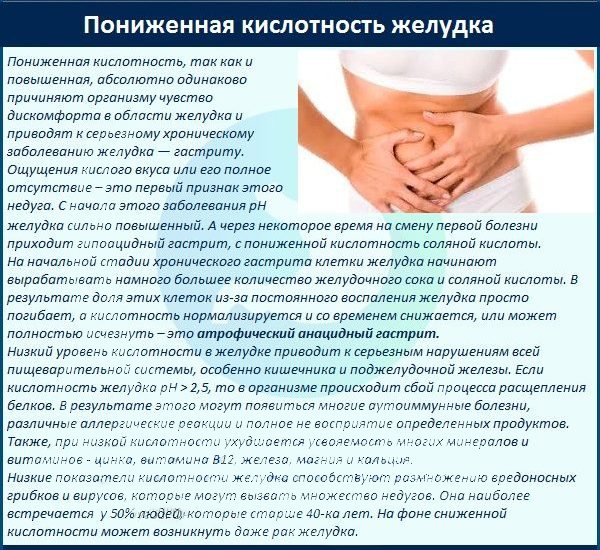
The disease is directly related to an insufficient amount of enzymes that are necessary for processing food. Doctors give recommendations regarding nutrition; they allow cereals to be included in the menu, but it is important to pay attention to the consistency of the dish. Since problems with digestion may arise, you need to serve a viscous dish that will not overload the stomach and create a feeling of heaviness. As in the case of eating buckwheat with high acidity, you must adhere to the following rules:
- Prepare soups using thin mushroom or meat (but low-fat) broths,
- To season the porridge, use vegetable oil, not butter,
- You can use vegetables and mushrooms as a side dish,
- You can supplement the dish with parsley, cilantro, celery, basil, parsley.
As additional precautions, it is suggested to use the following tips: make snacks regularly, but the portions should be small. Food must be chewed thoroughly, since the process of digestion begins in the mouth. A large number of healthy drinks not only diversify the menu, but also make it complete. It is recommended to serve buckwheat dishes with uzvars, compotes, jelly, and juices. Strict adherence to the diet prescribed by the doctor, as well as physical activity, can become the basis for recovery.
Buckwheat dishes for gastritis
Cereals can be used in different variations. Porridges are often prepared from it, but cooking offers to diversify the patient’s menu and prepare him soups, cutlets, porridges, casseroles, zrazy, etc. However, the proposed recipes cannot be called universal, since they need to be used for a specific disease
Gastritis with high acidity
Fry a small amount of porridge on a baking sheet or use a frying pan for this. Do not add any seasonings or oil. Use unprocessed grains for frying; after heat treatment, they should not get a dark brown, but a golden hue. Grind the finished product in a coffee grinder until it becomes grainy. You can make flatbreads out of it, use it to make cutlets, or eat it raw along with other foods. Take a few teaspoons with water or compote.

Gastritis with low acidity
It is not necessary to prepare the product only by heat treatment. You can use another method, especially when you need to get the maximum amount of valuable and nutritious elements from a dish. To prepare the porridge, use 300 ml of water (it should be hot), as well as 3 tbsp. l. porridge. Cover the container with a lid and leave overnight.
The finished buckwheat is blended in a blender until it becomes semi-liquid. Instead of water, you can use hot milk in the same proportion. For each meal, it is recommended to make a new portion of porridge according to this recipe. If it is difficult to eat uncooked cereal, you can reduce the portion and eat the dish every day for two weeks.
How to properly prepare and consume buckwheat for various forms of gastritis
Buckwheat is a healthy product; thanks to its rich vitamin and mineral composition, nutritionists call it the queen of cereals. With gastritis and other inflammatory diseases of the gastrointestinal tract associated with dietary habits, the question often arises: is it possible to eat buckwheat and will it harm health?
It is known that some types of cereals have an aggressive effect on the mucous membrane, but buckwheat is not one of them. You can safely include it in the menu, observing some rules and restrictions.
For gastritis with high acidity, patients are recommended treatment table No. 1 , for high acidity - table No. 2 (according to Pevzner). A proper diet for gastritis is the basis of complex treatment and prevents relapses of the underlying disease. Buckwheat is included in both diets, unlike semolina, barley, millet, pearl barley, and corn.
Buckwheat porridge is much softer; when properly prepared, it does not irritate the mucous membranes and enriches the body with valuable substances. Buckwheat porridge is especially useful if gastritis is combined with iron deficiency anemia, which often happens. A serving of porridge of 150 - 200 grams actually meets the daily requirement for iron.
Important! 100 grams of buckwheat contain 6.5-7 mg of iron, while the norm for an adult is 8-18 mg per day. In terms of amino acid profile, buckwheat is superior to oats and many other cereals.
The beneficial properties of buckwheat do not end there. Let's take a closer look at why cereals received the royal title from nutritionists.
Beneficial features
Buckwheat has high biological value. Contains a large amount of plant proteins that saturate the body with essential amino acids.
Due to its high starch content (up to 75%), buckwheat can replace potatoes and bread for people with diabetes.
part of the cereal germ is located inside the grain and is preserved during peeling. By including buckwheat dishes in your diet, you will get:
- vitamins B2, PP, E;
- amino acids: glutamic acid, arginine, valine, leucine, lysine and others;
- microelements: iron, magnesium, potassium, zinc, copper;
- organic acids: malic, citric, oxalic;
- polyunsaturated fats that can lower cholesterol levels and prevent cardiovascular diseases;
- lecithin, which is an active component of hepatoprotectors, restores hepatocytes and has a positive effect on the condition of blood vessels and the nervous system.
Buckwheat is indispensable in nutrition, especially for diseases of the stomach and intestines, which are accompanied by impaired absorption of many useful substances and the development of anemia due to iron deficiency. Buckwheat has a positive effect on diseases of the joints, liver, hypertension and atherosclerosis. To prepare crumbly porridge, the core is most often used.
How to use if you have high acidity
Buckwheat is allowed for gastritis with high acidity. It is part of treatment table No. 1, which is prescribed for increased secretion.
But for better absorption of the product, it is important to follow the general principles of nutrition, which the gastroenterologist always talks about. Of course, porridge fried with fatty meat and onions is by no means your option.
You should not flavor the dish with hot sauces and gravies made with flour; the best option is to cook the cereal in milk and add butter. To diversify your diet, consider non-acidic cottage cheese, sweet fruits and berries as supplements.
What to do during an exacerbation
In case of exacerbation of gastritis, liquid porridge with water and milk is allowed. The cereal should be boiled as much as possible, then it will not be tough and irritating to the inflamed gastric mucosa.
In the first 2-3 days of an exacerbation, it is better to eat porridge prepared not with kernels, but with ground grains or buckwheat jelly.
In the future, you can cook whole buckwheat, but without a side dish of fried vegetables and other prohibited foods.
Cooking options
For gastritis, it is better to consume buckwheat in the form of crumbly, liquid or viscous porridge with water or milk. You can add butter, a little sugar, dried fruits to it. The crumbly version is a complete side dish for boiled fish and steamed cutlets. But you shouldn’t use it too often, giving up other cereals. It is important to keep your diet varied.
If you are sorely short of time, cook buckwheat in a slow cooker . We tell you how to do this:
- Rinse the cereal until clean, cut the onion into rings, and grate the carrots.
- Lightly grease the multicooker mold with vegetable oil, put buckwheat with cooked vegetables there, you can add pieces of lean meat, and add salt.
- Fill with water until it covers the contents and is about 2 fingers higher. Set the “Pilaf” or “Stew” mode (15-20 minutes). And as a result, you will get a tender, crumbly porridge with soft meat and aromatic vegetables.
The dish simply melts in your mouth. Due to the high pressure, the cereal quickly boils, but at the same time retains its nutritional value.
Important! If you add little water, the buckwheat will be tough. The main thing is not to make mistakes with the volume of liquid.
Kissel
From finely ground buckwheat flour you can prepare an enveloping and very healthy buckwheat jelly. We offer a step-by-step recipe:
- Grind the finished group in a coffee grinder.
- For 3 tablespoons, take 300 ml of water (boiling water).
- Gradually add buckwheat powder to boiling water, cook over low heat until tender, stirring constantly.
It is better to consume this jelly on an empty stomach, so that the product has an enveloping effect on the mucous membrane and prevents irritation during the day. Prepare new jelly every day.
If your stomach hurts
If your stomach hurts after eating buckwheat porridge, pay attention to the quality of cooking. It is not recommended to pre-fry the grains. You should also not season buckwheat with fried vegetables or serve fatty meats with it, especially fried meats.
If pain occurs from eating regular buckwheat porridge, it is recommended to drink an infusion of flaxseeds before meals. It protects the mucous membrane well from possible irritation by food. Try drinking a little kefir on an empty stomach, and after 30-40 minutes eat buckwheat porridge.
Among medications, omeprazole taken half an hour before meals will reliably protect the stomach. Also, when heartburn occurs, antacids - Hefal, Almagel - help. Do not forget that all medications can only be used on the recommendation of a doctor.
Check out the video about the benefits of buckwheat and its healing properties:
Buckwheat for gastritis with high or low acidity is an irreplaceable product, rich in all necessary substances. But any cereal, even healthy, can be harmful if used incorrectly and if you violate the general recommendations of the prescribed diet. When properly prepared and thoroughly boiled, the porridge turns out soft, very nutritious and tasty.
Source: https://MedBrat.online/zheludok/gastrit/pitanie/grechka.html
